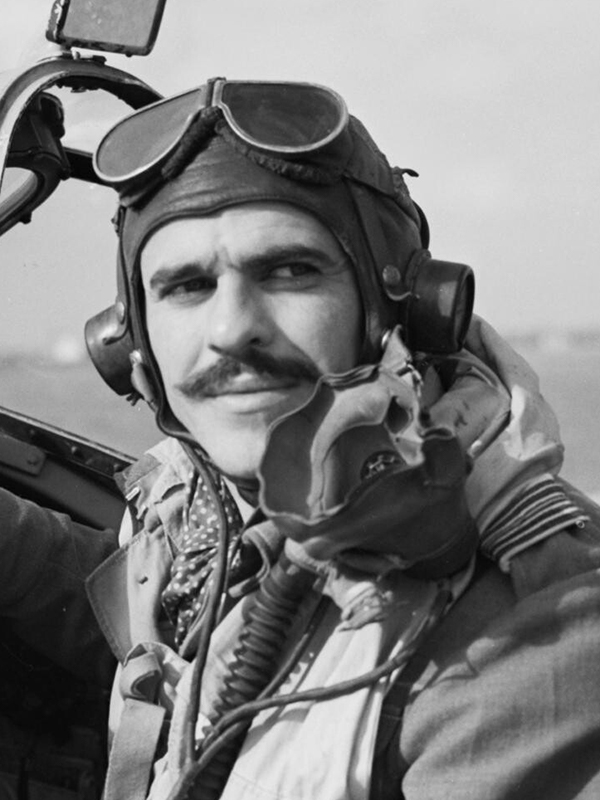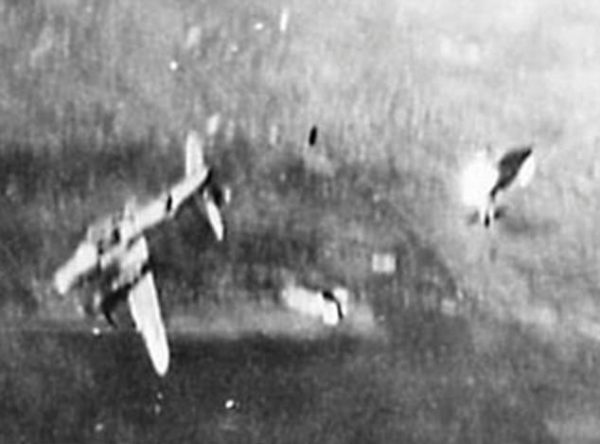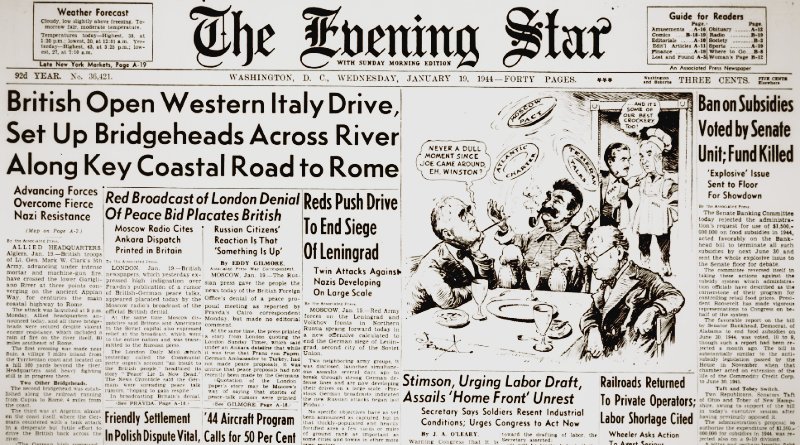World War II Chronicle: January 19, 1944
Click here for TODAY’S NEWSPAPER
The front page mentions the 158th Infantry Regiment, who got their baptism in fire in the Battle of Arawe. The “Bushmasters” are National Guard soldiers from New Mexico and Arizona and were federalized before America joined the war and sent to the Panama Canal Zone, where they became jungle warfare experts. The Japanese defenders on New Britain Island now face knife-wielding Native Americans who are sticking it to the Japanese. These soldiers also have the ability to communicate on the radio without worrying about the Japanese being able to understand anything they are saying…
Page two reports that the Mediterranean Theater’s top Allied ace has been killed in action. Wing Commander Lance C. Wade was born in Texas and tried to fly for the United States, but was told he needed a college degree. He instead headed to Canada and joined the Royal Air Force in 1940. “Wildcat” racked up 25 victories, with many more probables, survived being shot down behind enemy lines and evaded capture, and earned the Distinguished Service Order and a Distinguished Flying Cross with two bars…

Adapt, improvise, overcome: Marine fighter pilots have discovered a way to refrigerate beer in the Pacific Theater (see page three)… Also on three, the Navy is hinting they have a completely new strategy to deal with the Japanese strongholds of Rabaul and Kavieng — one which the enemy couldn’t possibly expect… In Sunday’s paper mentioned that the Army Air Force was trying to determine which pilot singlehandedly attacked a formation of 30 Luftwaffe fighters and now we know that it was St. Louis native Maj. James H. Howard (page nine)…
George Fielding Eliot gives a history lesson on page 10 as to why United Stares generals and admirals military have been limited to one or two stars, and why he thinks we need five-star flag officers for this war…
Page 14 tells of three District men who are now listed as Missing in Action. One is Army Air Force Staff Sgt. Herbert M. King, a veteran of some 20 bombing missions with the 555th Bomb Squadron. King was a tail gunner for a B-26B Marauder named Hell’s Fury, which was part of a Dec. 13 raid on Schiphol Aerodrome — now Amsterdam Airport Schiphol, the world’s third-busiest airport. The pilot of Hell’s Fury, Capt. Raymond Sanford, said that German flak was so thick you could walk on it, and their B-26 took a direct hit and broke apart while they were over the target. Sanford was wounded but survived and was quickly rounded up by the Germans and would spend the rest of the war as a prisoner. King never made it out of the tail cone.
Killed were King, Staff Sgt. Robert M. Becker, 1st Lt. Charles A. Jackson, Tech. Sgt. Sloan B. Peterson, Staff Sgt. William E. Turner, and Flight Officer Raymond C. Roberts. These men received a group burial at Arlington National Cemetery…

Also listed as missing is Staff Sgt. Jack L. Werber was born in Poland, but emigrated to the United States in 1937. He served in the Army Air Force’s 322nd Fighter Control Squadron and was a passenger aboard the troop ship HMT Rohna which was sunk off the coast of Algeria. Some 2,000 Americans were on the ship, which was attacked by a German radio-guided glide bomb — essentially the world’s first operational anti-ship missile — which was launched by a Luftwaffe bomber. Pfc. Earle G. Wilhoite Jr. is the third District native listed as missing in the article and he was also a passenger on Rohna. Stay tuned for more… Sports on page 17.
Roving Reporter by Ernie Pyle
IN ITALY — The dive-bomber has never been fully accepted by the Allied armies. The British have always been against it — they call the German Stuka a vastly overrated instrument of war — and America has more or less followed suit.
Our Navy has used the dive-bomber to good effect in the Pacific. But in the Mediterranean this weapon didn’t show up until the beginning of Sicily, and it has never been built up in great numbers.
In the dive-bomber groups over here we have several hundred pilots and mechanics who believe with a fanatical enthusiasm that the dive-bomber is the most wonderful machine produced in this war. I don’t want to enter into the argument, when I’m in no position to know, but regardless I’m going to write a little about these dive-bomber boys. For they are probably the most spectacular part of our Air Forces.
The function of the dive-bomber is to work in extremely close support of our own infantry. For instance, suppose there is a German gun position just over a hill which our troops cannot get at with our guns and is holding us up.
They call on the dive-bombers and give them the location. Within an hour, and sometimes much quicker, they come screaming out of the sky right on top of that gun and blow it up.
They can do the same to bunched enemy troops, bridges, tank columns, convoys or ammunition dumps. Because of their great accuracy they can bomb much closer to our own troops than other planes would dare. Most of the time they work less than a thousand yards ahead of our front lines, and they have had missions much closer than that.
The group I am with has been in combat six months. During that time they have flown 10,000 sorties, fired more than a million rounds of 50-caliber ammunition, and dropped three million pounds of bombs. That’s more than the entire Eighth Air Force in England dropped in its first year of operation.
Our dive-bombers are known as A-36 Invaders. Actually they are nothing more than the P-51 Mustang equipped with diving brakes. For a long time they didn’t have any name at all, and then one day in Sicily one of the pilots of the squadron said:
“Why don’t we call them Invaders, since we’re invading?”
The name was carried home in newspaper dispatches, and today even the company that makes them calls them Invaders.
The pilot who originated the name was Lieut. Robert B. Walsh, of Felt, Idaho. He has since completed his alloted missions and gone back to the States. His younger brother is now in the same squadron as a replacement pilot.
The P-51 Mustang is a wonderful fighter. But when you transform it into an A-46 by the addition of diving brakes it becomes a grand dive-bomber as well.
The brakes are necessary because of the long straight-down dive on the target. A regular fighter would get going too fast. The controls would become rigid, and the pilot would have to start pulling out of his dive so early that he’d have to drop his bombs from too great a height.
These boys dive about 8,000 feet before dropping their bombs. Without brakes they would ordinarily build up to around 700 miles an hour in such a dive, but the brakes hold them to about 390.
The brakes are nothing but metal flaps in the form of griddles about 2 feet long and 8 or 10 inches high. They lie flat on the wings during ordinary flights.
The dive-bombers approach their target in formation. When the leader has made sure he has spotted the target he wiggles his wings, raises his diving brakes, rolls on his back, then noses over and down he goes. The next man behind follows almost instantly.
They follow one right after the other, not more than 150 feet apart. There’s no danger of their running over the next one ahead, for the brakes hold them all at the same speed.
They’re so close together that as many as 20 dive-bombers have been seen in a dive all at once, making a straight line up into the sky like a gigantic stream of water.
At about 4,000 feet the pilot releases his bombs. Then he starts his pull-out. The strain is terrific, and all the pilots “blackout” a little bit. It lasts only four or five seconds, and is not a complete blackout. It is more a heaviness in the head and a darkness before the eyes, the pilots say.
Once straightened out of the dive, they go right on down to “the deck” which means flying close to the ground. For by this time everything in the vicinity that can shoot has opened up, and the safest place to be is right down close, streaking for home as fast as they can go.
Evening star. (Washington, D.C.), 19 January 1944. Chronicling America: Historic American Newspapers. Lib. of Congress.
https://chroniclingamerica.loc.gov/lccn/sn83045462/1944-01-19/ed-1/
